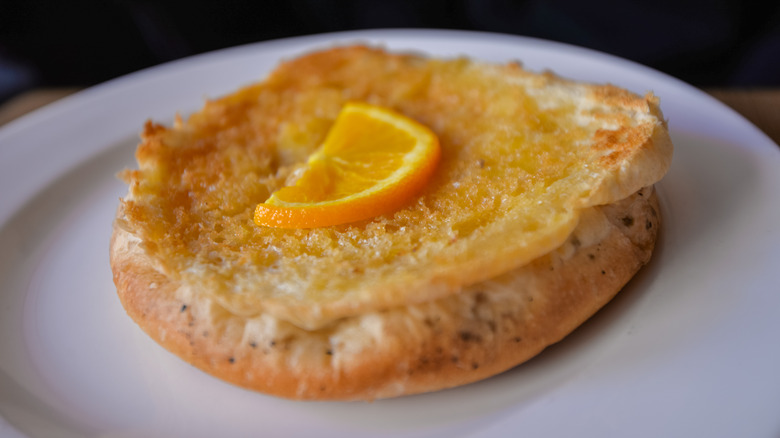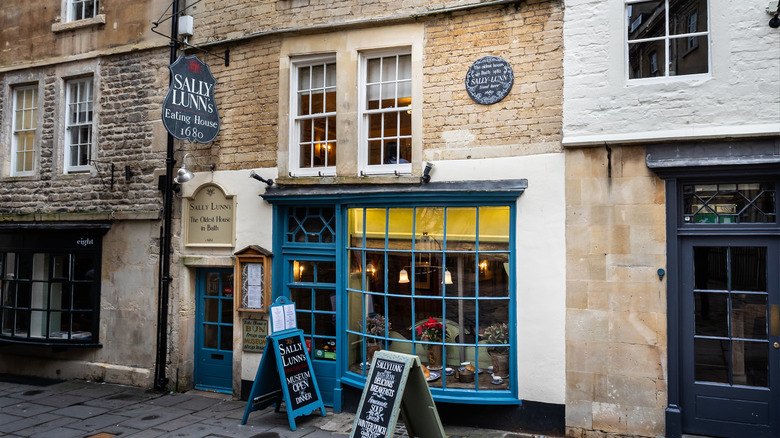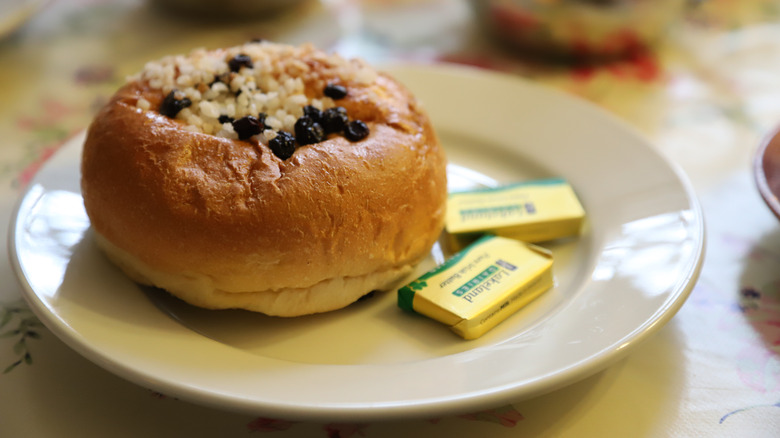The Mysterious Origin Of Sally Lunn Buns
Many foods and beverages bear the names of real people. Sometimes, it's the name of the creator themself, as is the case with Caesar salad, which was named for Caesar Cardini, an American restaurateur working in Mexico (via Merriam-Webster). Sometimes, the inventor names their creation in honor of a friend, as pharmacist Charles Alderton did when he named his new soft drink after one of his business's patrons, Dr. Charles Pepper (via Farmers' Almanac). Other times, the dish is given the name of an already famous person, giving it immediate name recognition, as was the case with Oysters Rockefeller, named for the fabulously rich oil baron John D. Rockefeller, and Peach Melba, named for the popular 19th-century opera singer Nellie Melba.
At first, the Sally Lunn Bun seems like it obviously belongs alongside the aforementioned foods. The popular British treat is most famously sold by Sally Lunn's Historic Eating House in Bath, England, which describes its signature offering as "part bun, part bread, part cake." Atlas Obscura calls the yeasted buns "denser than brioche and lighter than cake," noting that they may be eaten with sweet or savory toppings, or enjoyed all by themselves. The name of Sally Lunn is often attributed to a historical figure, much like Caesar Cardini or Dr. Charles Pepper, but this case is not as cut and dry as the others. The bun has become a point of contention between British and French culture, and nobody is exactly sure who deserves credit for its name.
The case for Sally Lunn as a real person
The name of Sally Lunn is popularly traced to a French woman named Solange Luyon, whose name was warped by the locals when she moved to England in 1680. Sally Lunn's Historic Eating House, which claims to be the woman's former home, begins her story with the oxymoronic phrase, "Legend has long been certain." As the tale goes, Luyon was a Huguenot refugee who found a new home in Bath where she made a career as a baker, drawing on her French roots to create the brioche-inspired bun that bears her Anglicanized name. The circumstances are certainly plausible. Britannica notes that hundreds of thousands of Huguenots (a heavily persecuted Protestant minority) fled France in the 1680s, many going to England. However, the other details of Solange Luyon's life are lacking.
According to Smithsonian Magazine, there are no contemporary records to verify that Ms. Luyon ever existed. In fact, her story was unknown until 1937, when Marie Byng-Johnson purchased the old Bath townhouse where Sally Lunn's now operates. Byng-Johnson claimed to have found Luyon's recipe for buns hidden in a secret cupboard in the home, giving her the "real" formula for the dish, and revealing all her bun-making competitors to be "fakes." Smithsonian suggests that Byng-Johnson made up the story of Solange Luyon to attract tourists, an idea supported by The Telegraph, which points out that Sally Lunn's Historic Eating House seems to be the only source of this popular tale.
Alternative origin stories
If Solange Luyon was not a real person, then where did the bun originate? Many sources point out that the Sally Lunn Bun is closely related to the Bath Bun, another popular treat from the same city. Smithsonian Magazine explains that the Bath Bun is smaller than the Sally Lunn, baked with sugar for a sweet finish, and probably descends from a similar dish called the Bath Cake. The existence of the Bath Bun may have provided some of the motivation for Byng-Johnson to create the story of Solange Luyon. The website for Sally Lunn's Historic Eating House includes multiple passages excoriating the Bath Bun as an inferior product and touting the Sally Lunn as "an altogether sturdier creation." But while this may partially explain why the legend of Sally Lunn has been so widely promoted, it doesn't get us any closer to the real namesake.
Food journalist Andrew Webb floats a possible theory in his book "Food Britannia." There's a warm brioche-style bun from France called solilemmes, of which the Sally Lunn may be an Anglicized version. Smithsonian Magazine also notes the connection but explains that there is insufficient evidence to prove a direct relation. But there's more. Both "Food Britannia" and the historical site Food Timeline find a very plausible source for both the names Sally Lunn and solilemmes. They may derive from the French phrase "soleil lune," sun and moon, a reference to the round bun with a golden top and a pale base.


